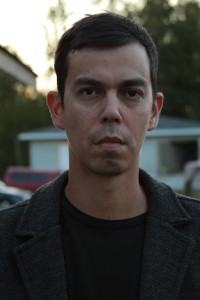 Christian Chapman lives and works in Thunder Bay, Ontario. He has taken fine arts courses at the Nova Scotia College of Art and Design and at Lakehead University, and has exhibited his work widely throughout Canada. His art practice focuses on storytelling as part of an oral tradition that has been an important part of the preservation and growth of Anishnawbe culture. Chapman’s work explores the act of storytelling in relation to his own heritage and how it has shaped his identity and personal experiences. By creating paintings that he considers visual stories, Chapman uses his art to help keep stories alive for future generations.
Christian Chapman lives and works in Thunder Bay, Ontario. He has taken fine arts courses at the Nova Scotia College of Art and Design and at Lakehead University, and has exhibited his work widely throughout Canada. His art practice focuses on storytelling as part of an oral tradition that has been an important part of the preservation and growth of Anishnawbe culture. Chapman’s work explores the act of storytelling in relation to his own heritage and how it has shaped his identity and personal experiences. By creating paintings that he considers visual stories, Chapman uses his art to help keep stories alive for future generations.
Julian Higuerey Núñez was born in London, England in 1983. He moved to Caracas, Venezuela at the age of two. There, he developed an interest in science and studied physics at the Universidad Simón Bolívar for four years before turning into Fine Arts. After completing a Bachelors degree at UNEARTE (formerly Instituto Universitario de Estudios Superiores en Artes Plásticas Armando Reverón) he relocated to Canada to get an MFA from OCAD University. His work has been exhibited in both solo and group shows in Brazil, Canada, Cuba, Mexico, Poland, Sweden and Venezuela, and his interest lay in the convergence of research, craft, critical and theoretical inquiry, economics, affect and labour as part of a contemporary art practice. His most recent show: “Modelo para una refinería petrolera de escala familiar” investigates notions of national identity, scale, industry and agency in the context of Venezuelan oil culture. He currently lives and works in Toronto.
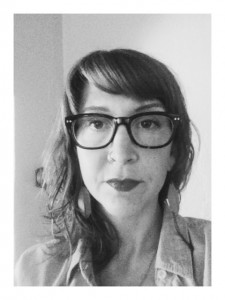 Jaymie Lathem in a visual artist based out of Northern Ontario. Lathem studied at the Ontario College of Art and Design, the Alberta College of Art and Design and received her BFA from Nipissing University in 2011.
Jaymie Lathem in a visual artist based out of Northern Ontario. Lathem studied at the Ontario College of Art and Design, the Alberta College of Art and Design and received her BFA from Nipissing University in 2011.
Lathem’s work is an exploration of individualism focusing on subtle visual cues each person owns and wears as uniquely theirs. While her portrait work captures a definite likeness to each model it also allows the idea that each individual pattern is ingrained much deeper than simple body structure.
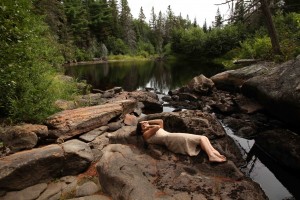 Tanya Lukin Linklater was born in a small Alutiiq village in Alaska in 1976. Based in northern Ontario, her practice spans experimental choreography, performance, installation, text, and video. She often investigates memory, the body, language, and sites in deconstructive and reconstructive ways in her work. Tanya has exhibited at Latitude 53’s Visualeyez (Edmonton), grunt gallery (Vancouver), Culver Center of the Arts (California), and at festivals in Canada and the United States. She studied at University of Alberta (M.Ed.) and Stanford University (A.B. Honours), where she received the Mellon Mays Undergraduate Fellowship & Louis Sudler Prize in Creative and Performing Arts. She was awarded the Chalmers Professional Development Grant (2010) and was nominated for the K.M. Hunter Artist Award in Dance (2011).
Tanya Lukin Linklater was born in a small Alutiiq village in Alaska in 1976. Based in northern Ontario, her practice spans experimental choreography, performance, installation, text, and video. She often investigates memory, the body, language, and sites in deconstructive and reconstructive ways in her work. Tanya has exhibited at Latitude 53’s Visualeyez (Edmonton), grunt gallery (Vancouver), Culver Center of the Arts (California), and at festivals in Canada and the United States. She studied at University of Alberta (M.Ed.) and Stanford University (A.B. Honours), where she received the Mellon Mays Undergraduate Fellowship & Louis Sudler Prize in Creative and Performing Arts. She was awarded the Chalmers Professional Development Grant (2010) and was nominated for the K.M. Hunter Artist Award in Dance (2011).
Her artistic practice is generally more concerned with intimacy than spectacle in terms of subject matter (the experiences of women’s work, domestic spaces and memory). She is also compelled by how memory is embodied and activated in the present moment.
She has investigated the forms and meanings of traditional dance in Alaska for over ten years, most recently with research support from the Ontario Arts Council and Canada Council for the Arts. This research has often led her to engage with anthropological and ethnographic text. She has worked with contemporary dancers in movement investigations, a process of deconstructing the principles of the dances in order to construct new movement forms. She has utilized a similar process with her indigenous language in live performance.
She sometimes investigates what it means to be indigenous or not indigenous to a location, which is why much of her work happens in sites rather than black box theatres or studios.
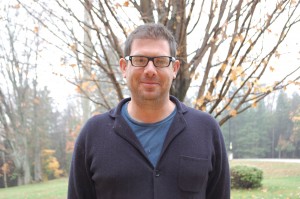 Kevin Yates‘ work has often been inspired by classic and popular films. From these recognized stories and images he extracts a character, a theme or detail and renders them as miniature sculptures. He is drawn to the power of the miniature to intrigue and involve on this scale. His work, often heavily suggestive of narrative, has more recently begun to incorporate the use of reflection and mirroring in both video, photographic and sculptural mediums. Through this use of reflection, a focus on water and the natural and its intersection with the cultural or narrative has begun to develop. Through this he has been able to further explore the relationship between the solidity of sculpture referencing the photographic and the photographic being used to suggest the sculptural.
Kevin Yates‘ work has often been inspired by classic and popular films. From these recognized stories and images he extracts a character, a theme or detail and renders them as miniature sculptures. He is drawn to the power of the miniature to intrigue and involve on this scale. His work, often heavily suggestive of narrative, has more recently begun to incorporate the use of reflection and mirroring in both video, photographic and sculptural mediums. Through this use of reflection, a focus on water and the natural and its intersection with the cultural or narrative has begun to develop. Through this he has been able to further explore the relationship between the solidity of sculpture referencing the photographic and the photographic being used to suggest the sculptural.
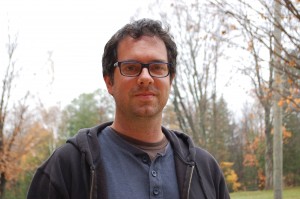 Robert Yates was trained as an experimental narrative film maker and has from the onset been concerned with issues of veracity and illusion when using recorded images. Of particular concern is the problem of giving voice to the natural world in a way that both seeks the authentic and recognizes its near impossibility. His work has often utilized the surreal or fantastic in order to focus on the human confronting nature in both its interior and exterior manifestations and the problem of achieving this through something free of invention, fantasy or even logic. The problems resulting are put forth often as competing or inter-relating dualities such as the domestic/wild, self/non-self, interior/exterior spaces, the real/imagined.
Robert Yates was trained as an experimental narrative film maker and has from the onset been concerned with issues of veracity and illusion when using recorded images. Of particular concern is the problem of giving voice to the natural world in a way that both seeks the authentic and recognizes its near impossibility. His work has often utilized the surreal or fantastic in order to focus on the human confronting nature in both its interior and exterior manifestations and the problem of achieving this through something free of invention, fantasy or even logic. The problems resulting are put forth often as competing or inter-relating dualities such as the domestic/wild, self/non-self, interior/exterior spaces, the real/imagined.
